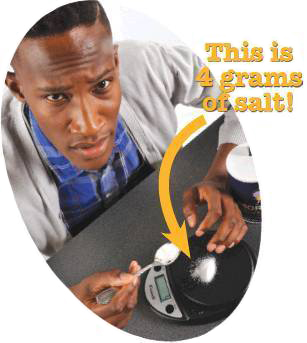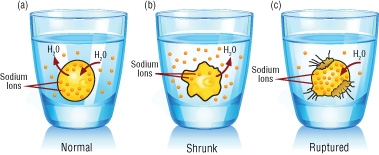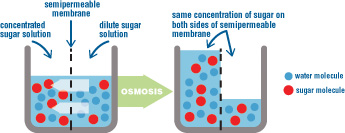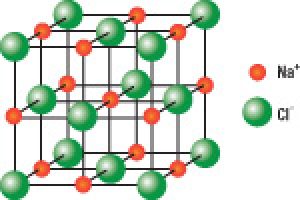Shaking Out the Facts About Salt
By Chris Eboch February 2016

Potato chips, popcorn, pretzels, nuts. These popular foods all have something in common—lots of salt. Many people find a salty taste pleasant, but salt does more than simply add saltiness. It can also enhance sweetness and hide unpleasant metallic or chemical flavors, rounding out the overall balance of flavors and improving the taste of food. Flavor can also be enhanced by adding herbs, spices, and vinegars, but adding salt is a cheap and easy way to make food taste good.
Unfortunately, taking too much salt has been associated with high blood pressure, which can damage the heart and blood vessels and increase the risk of a heart attack and stroke. For decades, the U.S. government and the American Heart Association have recommended consuming less salt. But reduced consumption of salt has not been shown to reduce blood pressure and has not led to a decrease in heart attack and stroke in the U.S. population. Yet current guidelines still call for limiting salt intake to stay healthy. So how much salt do we actually need to take to stay healthy?
Health effects of salt
Cutting back on salt can reduce blood pressure, but often, the change in blood pressure is small. According to the American Heart Association, a person who reduces salt intake from median levels (around 3,400 milligrams (mg)) to the federal recommended levels (no more than 2,300 mg) typically sees a slight drop of 1% to 2% in blood pressure, on average.
Also, other factors affect blood pressure. For example, blood pressure increases with weight gain and decreases with weight loss. So, keeping a healthy weight can help prevent high blood pressure. Eating foods high in potassium also seems to counter some of the effects of high salt consumption on blood pressure.
Studies comparing salt intake in different countries worldwide have not found a clear connection between salt intake and high blood pressure. Societies that eat lower levels of salt do not necessarily have less heart disease than those that eat a lot of salt.
In addition, salt directly affects other nutrients. For instance, consuming a lot of salt may cause more calcium to be excreted in the urine. Calcium is a mineral that helps to strengthen bones, so people on a high-salt diet may need more calcium to make up for the calcium lost (along with the excess sodium). Also, urinary calcium, the main constituent of kidney stones, is increased by a high salt diet. Therefore, a high-salt diet can lead to painful kidney stones.
How much is enough?
Surprisingly little is known about how much salt we need. U.S. residents consume, on average, about 3,400 milligrams of salt per day. For decades, the U.S. government and organizations, such as the American Heart Association, have recommended people consume less salt. Current dietary guidelines recommend no more than 2,300 mg of sodium—about a teaspoon of salt—per day for teens and adults. No more than 1,500 mg per day is recommended for groups at higher risk of heart disease, including African Americans and everyone over the age of 50.
The U.S. dietary guidelines were established in the 1970s when relatively little information was available about dietary salt and health. The guidelines were the best guess, given the information available at the time. However, the guidelines made little difference in people’s behavior. Between 1957 and 2003, U.S. residents consumed, on average, 3,400 mg of salt per day.
Also, over the years, salt consumption remained steady, even though manufacturers added more salt to commercial foods. This consistency in salt intake suggests that people may somehow automatically regulate the amount of salt they eat. If that is true, does it mean people instinctively choose the right amount of salt? Or perhaps people used less salt at the table in an attempt to follow the new guidelines but unknowingly consumed more salt in their prepared foods.
Some scientists now say that the average amount of salt U.S. residents eat (3,400 mg of salt per day) is safe and may even be healthier than the lower government guidelines. In fact, a study found that people who meet the U.S. recommended limits for salt (2,300 mg of sodium per day) have more heart trouble than those consuming more salt. This study included approximately 150,000 people from 17 countries and was published in the New England Journal of Medicine.
Scientists challenging the current guidelines say people should consume at least 3,000 mg of salt per day and up to 6,000 mg per day. The new research results suggest a low-sodium diet may stimulate the production of renin, an enzyme released by the kidneys. Renin plays a role in regulating the body’s water balance and blood pressure. Too much renin may harm blood vessels, and a high-sodium diet would help lower the amount of renin produced.
Why we need salt
So why do we need salt in the first place? Salt, especially the sodium ions (Na+) present in its NaCl structure, is essential to the functioning of every cell in our bodies. Compounds containing sodium and potassium are electrolytes, substances that dissolve in water and produce ions. The resulting solution conducts an electric current. In the human body, many processes require electrical signals for communication, especially in the nervous system, brain, and muscles. For example, sodium ions are necessary to generate those electrical signals. Too much sodium, or too little, can cause cells to malfunction (Fig. 1) and, if taken to an extreme, can be fatal.
Sodium is the major positive ion in bodily fluids, so its concentration determines the total concentration of solutes—called the osmolarity—in these fluids. When two fluids with different osmolarities are separated by a membrane, then water tends to flow through the membrane to equalize the concentrations. Through a process called osmosis (Fig. 2), water moves across the semipermeable membrane from an area of low solute concentration to an area of high solute concentration.
Click image to enlarge
Figure 2. Osmosis is the spontaneous movement of solvent (here, water) molecules through a semipermeable membrane from a region of low concentration of solute (here, sugar) molecules. The end result is that the solute concentrations are the same on both sides of the semipermeable membrane.
In the case of bodily fluids, the fluid inside cells is separated from the fluid in the blood. So, if the osmolarity of blood is not balanced with the osmolarity inside cells, the total volume of liquid in the cells may increase or decrease. Without enough sodium, the body’s fluids would lose water, causing dehydration, low blood pressure, and possibly death.
Salt is excreted through urine and through sweat. Because salt is excreted from the body, it must be constantly replaced. However, most people choose to continue eating salt, even when their needs have been met. Could people benefit from consuming higher levels of salt for reasons scientists do not yet understand? Some researchers suggest that high salt consumption is merely a habit learned in childhood or, possibly, an addiction. Others suggest that evolution has given people a taste preference for salt, even when they do not need it.
How much salt do you need?
If you are athletic and eat a low-salt diet, you may be getting too little salt. However, if you eat a lot of processed foods, you may be getting more salt than you need. As is probably clear to you by now, scientists and the medical establishment have not yet agreed on the optimal amount of salt people should get, but for most people, moderation is a good option.
You can estimate your daily intake of salt by paying attention to the nutrition labels on food. Some foods, including ready-to-eat foods such as items from the deli or bakery, are not required to have nutrition labels. If you eat a lot of these foods, or a lot of restaurant foods, it is harder to count your salt intake. However, you can find nutrition information for many restaurants, and deli and bakery items. Search for “nutrition information” and the name of the item. MyFitnessPal (www.myfitnesspal.com) also offers a free mobile app, and the online site lists nutrition information for thousands of products.
Blood tests can confirm your blood sodium level. If you discover that you eat too much salt, try to cut back on high-salt foods or add little or no salt to your food at the table. If food lacks flavor, you can try adding spices or herbs instead.
Selected references
Zaraska, M. Pass the Salt, Please. It’s Good for You. The Washington Post, May 4, 2015:
http://wpo.st/GFtG0 [accessed Nov 2015].
Ballantyne, C. Strange but True: Drinking Too Much Water Can Kill. Scientific American, June 21, 2007: http://www.scientificamerican.com/article/strange-but-true-drinking-too-much-water-can-kill/ [accessed Nov 2015].
Sodium (Na) in Blood. WebMD, Sept 9, 2014: http://www.webmd.com/a-to-z-guides/sodium-na-in-blood [accessed Nov 2015].
Chris Eboch is a science writer who lives in Socorro, N.M. Her most recent ChemMatters article, “Geothermal Power: Hot Stuff,” appeared in the December 2015/January 2016 issue.
What Is Salt?
In chemical terms, salts are ionic compounds. To most people, salt refers to table salt, which is sodium chloride. Sodium chloride forms from the ionic bonding of sodium ions and chloride ions. There is one sodium cation (Na+) for every chloride anion (Cl–), so the chemical formula is NaCl (Fig. 1).
The element sodium is very reactive and can even react explosively with water. For this reason, it is not found free in nature. In table salt, sodium is in the form of sodium cations (Na+), which separate from the chloride anions (Cl–) when the salt dissolves in water.
Sodium, located at the far left of the third row of the periodic table, has only one valence electron. Because its nucleus has a relatively small effective positive charge, it readily loses this outer electron. In contrast, chlorine, at the other end of the same row of the periodic table, has built up six additional protons and so has a great affinity for electrons and can readily accept one more in its valence shell of electrons. Stability is achieved when sodium’s one valence electron is transferred to chlorine, producing sodium chloride.
—Chris Eboch
Sources of U.S. residents’ sodium intake
- 77% from packaged and restaurant food.
- 12% from foods that contain sodium naturally.
- 11% from adding salt to food while cooking or at the table.
Also in the February 2016 Issue...
How do we determine how much salt we need? By looking at people’s diets and how their diets affect their health. Sounds easy? Actually, it is not.






